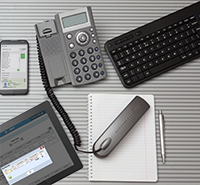14 Agencies Describe How They Use Biometric Fingerprint Readers for Time & Attendance for Staff and Clients
Not long ago, very few agencies would have used biometric fingerprint readers in day programs, let alone group homes. Today, all that has changed. The current range of biometric fingerprint readers are affordable, deliver a quick return-on-investment, and are suitable for use in three- to four-bed group homes. They also have many advantages over other time and attendance methods like PCs and telephone timekeeping.
These interviews will help you learn more about the pros and cons of biometrics in an agency setting. Read the responses from managers, administrators, and employees about how biometrics have worked for their agencies. These providers are using biometric fingerprint readers in day programs, group homes, and at contract job sites. Biometric fingerprint readers are primarily for the staff, but some providers encourage clients to use them as well.
The Ron Wilson Center, Oregon
The Ron Wilson Center is a private non-profit agency in Monmouth, Oregon. A group of parents, students, and concerned citizens founded the agency in 1974. The Ron Wilson Center is now a leader and innovator in providing services to people with I/DD. The agency currently serves about 65 individuals in a variety of programs that include residential services, supported living, and day support activities.
Before setting up biometric fingerprint readers, the Ron Wilson Center was using MITC telephone timekeeping. Loralee Poppitz, the accounting services director, says the primary reason for the switch was timesheet fraud. The agency suspected some employees were buddy punching with the telephone timekeeping system. “With the biometric fingerprint readers in place, we know the staff has to be there in order to clock in, eliminating any chance of buddy punching,” she says.
Loralee tells us that the biometric fingerprint readers have worked out well so far. “It was easier to install them in the homes a few at a time, and it was more cash flow-effective to spread out the expense,” she says. “We registered employees’ fingerprints into the biometric fingerprint readers when they came to pick up their paychecks. We then went to the group homes to catch the few employees we missed.” The agency now has 160 out of 175 employees entered.
As far as power and internet connectivity issues, Loralee tells us that, “We had the internet go down in one of our homes, but not the power. The biometric fingerprint reader still captured the punches. When we got the internet back up, it transferred all the punches.”
Implementation
The agency staggered the implementation in three groups. After purchasing the system in January 2017, they installed the first batch in five group homes in February, then added the second set of five in March, and they are getting ready to do the last six now. “The conversion went smoothly. The hardest part as a larger organization was capturing all the employees,” Loralee says.
She found a clever way to help employees learn this new way of clocking in: “We sent out fliers to the group homes and posted a cheat sheet we got from MITC next to all of the biometric fingerprint readers. This is our third month using it and it seems to be working fairly well.”
The enrollment and training process can be intimidating for some providers, especially larger ones. Many agencies integrate enrollment into the training process. Loralee, for instance, sets up new hires on the first day of training, and they start using them right away. Sometimes, people must scan their fingers twice if they are too cold or wet. However, most people use the fingerprint readers without a problem.
East End Disability Associates, New York
East End Disability Associates (EEDA) is a non-profit organization that provides services for people with I/DD. A small group of parents organized EEDA in 1992 as a grassroots agency. They were active advocates for their children and believed that everyone has the right to fully participate in quality education, medical, habilitation, and recreational services. To that end, EEDA secured funding to create programs that promote life enhancement for people of all ages with I/DD. Today, EEDA provides services to over 700 individuals. The same group of parents that started the organization continues to manage it.
EEDA installed just one biometric fingerprint reader a few years ago. For a while, it was the only one. Now, however, the agency uses fingerprint readers at four locations and is rolling out a new one each month. In total, it plans to use biometrics at 12 sites. Currently, two biometric fingerprint readers operate in day habilitation facilities, two in residential facilities, and one in the main office. The future fingerprint readers will be in residential and crisis house locations.
System Administrator Dan Bogan cites ease-of-use and reliability as the reasons EEDA uses biometrics. The biometric fingerprint readers are easy and quick for the staff to use. “East End Disabilities has many locations where a lot of employees have to clock in in a short amount of time,” Dan says. “There is limited access to telephones at some sites, and while dialing in is quick with the phone, biometric fingerprint readers are faster.” Also, the agency has experienced electrical issues that interfere with its server. If the server goes down, the fingerprint readers store attendance records until the server is backed up. This guarantees that time & attendance is always accurate, even in the case of a server outage.
Implementation
Since adopting the biometric technology, EEDA has created a few new procedures to streamline enrollment for new employees. Originally, employees enrolled in the fingerprint readers at their work sites. Now, HR enrolls them at the main office during orientation, and that fingerprint reader automatically shares the fingerprints at all of the locations.
The implementation of biometrics has been an overall success for EEDA. Dan extols the benefits, saying, “The biometric fingerprint readers are very good. They save a lot of time for employees clocking in and out, and there are fewer missed punches.”
Hands of Heartland, Nebraska
Hands of Heartland is dedicated to growing new opportunities for adults with physical and intellectual disabilities. The agency provides day, residential, and respite services.
Hands of Heartland has been using biometric fingerprint readers since September 2015. HR Director Trina Leech says biometrics have been “a quick and accurate way to get a large number of people processed in and out at the beginning and end of the day.” She also says buddy punching is now a thing of the past.
Biometrics have helped to streamline the agency’s payroll process, too. “Supervisors can quickly identify if a staff member has not properly clocked in and out,” Trina explains. “Previously, we used paper timesheets and supervisors manually calculated time worked for 200 total employees. We’ve saved approximately 20 hours per pay period and we are running payroll twice a month.”
Looking back, Trina says she wishes the agency would have used biometrics earlier. “You wouldn’t believe the difference it’s made in processing payroll. It has significantly eliminated errors. Prior to MITC, we would have 10–15 employees a pay period with errors. I no longer have people coming to my office with issues. It has also saved time for supervisors, who are checking MITC on a daily basis and are able to wrap up any corrections within 48 hours of a pay period ending. This allows them to focus more of their attention on other tasks.”
Trina says the switch to MITC was a worthwhile expense. “It was an investment to go from paper timesheets to time and attendance, but it has paid off. We are now looking to add other modules like scheduling. We hope scheduling will help our ability to control overtime hours and staff to client ratios.”
Implementation
The agency has encountered minimal issues with the implementation. A couple employees had trouble using the fingerprint readers due to skin condition and dexterity. The agency allows those employees to enter their employe PIN numbers instead. One other employee’s fingernails were too long to fit in the fingerprint reader, but she had no problems after cutting her fingernails shorter.
Often, agencies that have had a negative experience with a previous system are wary to try something different. Trina says this was true at Hands of Heartland. Since implementing biometrics, however, Trina found that the most reluctant supervisors are now the happiest. “The supervisors say they have so much time to do other things now,” Trina tells us.
MITC has found that a time & attendance system will achieve higher compliance levels if known and effective policies and procedures are in place. Trina learned this firsthand. “I met with each supervisor to go over the process and helped them with a payroll or two. It was a little bit of hand holding up front but it paid off. A lot of the supervisors are truly caregivers at heart and so this technology is somewhat scary, but they now have the confidence they needed to take off with it. With the supervisors on top of it, employees get on top of it because they don’t want to be the person with several corrections in a pay period.”
The agency also uses incentive programs to encourage staff to properly use the system. “In our day centers, if employees go an entire month without corrections, they get a $10 gift card. That program is going to get expensive soon, but it got us a lot of buy in and we’ve had no problems with new employees,” Trina says.
North Star Community Services, Iowa
North Star Community Services is a non-profit agency serving Northeast Iowa and beyond. Since 1975, it has been helping disabled adults live enriched and empowered lives in the community. The agency provides adult day services, employment services, and supported community living services.
North Star Community Services implemented biometric fingerprint readers about two years ago. Now, 35–40 employees using biometrics in their day programs. While some employees were resistant at first, they eventually came to appreciate the convenience of the biometrics. When the agency had to send some of the fingerprint readers out for repairs, the employees complained about having to use telephone timekeeping. They missed the faster, easier fingerprint readers.
HR Director Bridget Hartman says biometrics have been super convenient for employees. “We have MITC set up so employees’ lunches are automatically deducted if an employee works at least a 7-hour shift,” she says. This means employees don’t have to waste any of their lunch break walking to the fingerprint read on the other side of the building. Instead, HR automatically accounts for a lunch break. In an employee skips a break, a supervisor can override the process.
Also, biometrics have increased payroll accuracy at North Star. She says: “We would recommend biometric fingerprint readers to any agency that has a large group of employees, even if you already have another time and attendance system in place. Our goal was to speed up the amount of time employees spent clocking in and out while getting an accurate record of employee attendance. The biometric fingerprint readers have achieved that goal.”
Implementation
As we have heard from other agencies, long fingernails posed a problem for some North Star employees. But Bridget explains that MITC easily resolved this issue. “Over time, [long fingernails] damage the prism on the biometric fingerprint readers where employees place their finger to clock in and out. We recently had to replace both prisms in our biometric fingerprint readers, but MITC came to the rescue and replaced the prisms in a timely matter without any complications.”
On My Own, Missouri
On My Own is a non-profit, non-residential independent living center in Missouri. Since 1997, it has been assisting disabled individuals in five counties.
The agency has been using biometric fingerprint readers for three years for 26 office employees. Prior to the fingerprint readers, On My Own didn’t have any system for time & attendance for the office staff. CFO Patti Hendrix says, “We wanted an onsite system that guaranteed employees were present.”
Patti found that biometrics reduced overtime throughout the agency. “Biometric fingerprint readers have kept a better control on overtime. We have found employees working when not scheduled and have eliminated those issues. MITC also helps us with payroll.”
When compared to other timekeeping methods, Patti agrees that biometrics surpass them all in terms of ease-of-use. “Scanning a finger is easy,” she says. “It just becomes a habit!”
Implementation
The only issues On My Own experienced while implementing biometrics were isolated cases where the biometric was unable to read particular fingerprints. Patti explains that about five people have consistent problems. But for the most part, the system has been accurate and timely.
In regards to the agency’s enrollment and training process, Patti tells us that, “On My Own has an employee orientation and explains how the procedure works just to give a little detail. We also added a part to the employee training where we require new employees to practice using the biometric fingerprint readers. We include that with the rest of the training on how to use MITC.”
The Arc Baton Rouge, Louisiana
The Arc Baton Rouge was founded in 1950 from a grassroots movement of families working to create services for children and adults who were being denied day care, educational opportunities, and work programs. Today, The Arc Baton Rouge is one of 19 affiliated Louisiana chapters and nearly 700 nationwide. It provides individual and public policy advocacy, residential and housing supports, educational assistance, vocational training, and employment solutions and recreational activities.
One reason many agencies select biometric fingerprint readers is that clients with certain disabilities can use them. This encourages their independence, as Time & Attendance Specialist Jenny Bulkley discovered. “The clients we serve have a wide range of abilities and aptitudes,” she says. “The ones who can use the biometric fingerprint readers love it. The biometric fingerprint readers give them more autonomy. The clients love to come and put their fingerprint on the scanner or enter their employee number, and benefit from the feeling of independence it gives them.”
MITC allows agencies to mix and match timekeeping methods depending on the program. While the Arc Baton Rouge uses biometrics for state contract clients, it uses Door Clock in the vocational program. “We chose to use Door Clock in the vocational program because our clients have greater disabilities,” she explains. “Some have retracted hands or limited intellectual capabilities. These clients had difficulty getting fingerprints to work.” This ability to utilize a mix biometrics, telephone timekeeping, and Door Clock has been a huge advantage for The Arc Baton Rouge.
Implementation
Jenny has found that the biometric fingerprint readers are very easy to use for almost everyone at the agency. “We love that employees don’t have to pick up and call as with telephone timekeeping. There is such a slim margin for error because there is nothing for the employee to enter. With telephone timekeeping, it is possible that employees enter the wrong job or the wrong code. The only issue we have experienced with the biometric fingerprint readers is that they cannot be used by individuals with a hand-related medical condition.”
Though new technology can often cause apprehension, Jenny’s training from MITC reassured her. “Everything was relatively easy. When I first opened the box, it was a little intimidating, but I love working with MITC. The support people are great. I only needed to go over everything in training one time before I had it down.”
Most importantly, biometrics have helped the agency achieve its goals and improve the quality of life for the individuals it serves. As Jenny puts it, “Because biometric fingerprint readers increase the autonomy of our employees, it helps us with our mission of encouraging independence.”
Northern Transition, Michigan
Northern Transitions is a private, non-profit agency in Michigan. It provides a range of vocational rehabilitation services to individuals with barriers to employment. Services include evaluation, supported employment, community placement, and numerous types of employment within the organization for individuals who require a high level of continued support.
Northern Transitions has been using biometric fingerprint readers for about two years. Right now, 50 employees (staff and clients) use them. The main reason the agency chose biometric fingerprint readers over telephone timekeeping was a lack of phone service and internet at their contract sites. The fingerprint readers don’t require internet connection or phone lines; they only need a USB drive so supervisors can download the attendance records.
The agency currently has two biometric fingerprint readers installed. Executive Director Joel Krupa tells us, “One is located at a SourceAmerica contract site at the international border station in Sault Ste. Marie, Michigan. It’s essential to have one there because we can’t have internet there due to regulations. We had a phone line there but removed it since everyone nowadays has cell phones; and we don’t need a phone line for the biometric fingerprint reader to work. Our other location is at our recycling center that we operate.”
The Benefits
Joel says that the biometrics have been easy for everyone to use. “We only had one incident where the person trying to register their fingerprint into the biometric fingerprint reader couldn’t get their fingerprint scanned. We just have that person using their 4-digit PIN for clocking in and out. Other than that, the biometric fingerprint readers are pretty simple to use. The results are less missed/wrong punches being entered,” he said.
Joel believes the agency’s payroll costs would likely be higher without the biometric fingerprint readers. “If you use paper timesheets at your agency, there is a possibility for a lot of inaccurate times. If you had multiple individuals on any given day leaving work at 3:20 or 3:25 when their shift would end at 3:30 and claiming to be leaving on time, it would all add up to a loss. The preciseness of the biometric fingerprint readers eliminates this issue,” Joel claims.
The benefits of biometrics have been numerous for Northern Transitions. As Joel discovered, “The biometric fingerprint readers are efficient for agencies to use. They aren’t complicated for employees to use. For our model, there isn’t internet or any phone lines required. They help eliminate payroll issues. Also, they are cost-effective for agencies to invest in because the price has come down a lot.”
Supportive Concepts for Families, Pennsylvania
Supportive Concepts for Families is a large provider serving individuals with I/DD throughout Pennsylvania. The agency manages multiple programs, including residential and family community living, home-based waiver services, supported living, adult training, behavioral health, and transportation.
Supportive Concepts has been using biometric fingerprint readers for several years now. Mark Kellenberger, Vice President of Information Systems, says convenience was a big reason for choosing biometrics. For example, using a biometric fingerprint reader in the adult training facilities prevents long lines to clock in or out, because the process is so quick. The second reason the agency chose biometrics was to eliminate buddy punching.
Looking back, Mark recalls only one issue with the fingerprint readers: “One of our group homes is on an old Verizon DSL line and the circuit is unreliable. Other than that, the biometric fingerprint readers have worked out and are generally available.”
He concludes that, “In the right situation, biometric fingerprint readers are really worth it. Where we get the biggest return on our investment is at our adult training facility. We have a large number of employees clocking in and out around the same time and the biometric readers are excellent for that type of situation. In the smaller homes, we don’t have a large number of employees coming in at the same time, but having that security factor is vital.”
Implementation
During implementation, some of the supervisors struggled to learn how to enroll employee fingerprints into the readers. “But that seems to be a non-issue now,” says Mark. “There is the occasional problem of an employee’s finger not being readable, but all things considered, they’re pretty low maintenance.” Employee enrollment was also fairly painless. “Since everything flows into the database, there are a couple of different ways for us to enroll an employee. We can have the employees register their fingers at their work site or at the central office. But recently, we’ve had our employees just scan their fingerprints at their respective work sites,” Mark explains.
Mark says that the fingerprint readers have effected the entire organization positively. “Our people know that we check, so I believe that there is some downstream effect. Employees are aware that we have biometric fingerprint readers installed in some houses, and even though they don’t have them installed in their workplace, they do what they’re supposed to do in regards to being honest about clocking in and out.”
Center for Life Enrichment, Maryland
The Center for Life Enrichment aims to increase the vocational and personal potential of individuals with disabilities in Maryland. Currently, the agency serves over 200 individuals through supported employment, community learning services, day habilitation, and family and individual support programs.
Center for Life Enrichment implemented biometric fingerprint readers about six years ago. It currently uses four biometric fingerprint readers between two stores.
Like many other agencies we spoke to, Center for Life Enrichment was previously using paper timesheets, which was vulnerable to fraud and errors. “This method lacked visibility into when workers were present,” says Executive Director Randy Ferguson “We knew it was possible employees were being dishonest about what time they actually arrived and left for the day. Installing biometrics made the employees’ time indisputable and completely eliminated inaccurate timesheets.”
The Benefits
Once employees began using biometric fingerprint readers, Center for Life Enrichment saw fewer late arrivals. Randy tells us, “Employees can no longer dispute whether they were on time with the biometric fingerprint readers, compared to when paper timesheets were in place. This prevents our employees from being paid for a full shift when they arrived late or left early without notifying their supervisor.”
Aside from a few instances of skin care products interfering with the reader, Center for Life Enrichment has had no problems. Training and compliance have also been simple. “On a new employees’ first day of orientation, we scan their fingerprints into the system. It is a part of the new hire procedure on day one,” says Randy.
Because biometric fingerprint readers are inexpensive, agencies with many users can afford multiple readers. “If an agency has a lot of employees/clients (like our stores do) clocking in and out around the same time, there is a huge advantage to having multiple biometric fingerprint readers. This facilitates faster clocking in and out and prevents employees having to wait in line for their fellow employees to finish,” Randy discovered.
In addition, employee attitudes have shifted in a positive direction as a result of the biometrics. “Since installing the biometric fingerprint readers, we have noticed the employees previously coming in late and claiming to be on time are now showing up as scheduled. Partial absenteeism (late arrivals) has declined,” Randy proclaims.
Advantages of Southeast Arkansas, Arkansas
Advantages of Southeast Arkansas, provides community-based services geared toward maximizing independence, self-support, and employment opportunities for persons with developmental disabilities in a 14-county service area. The agency manages HCBS, transportation, preschool, community waiver, adult day treatment, therapy, supported living, and family support programs.
Approximately 85 employees use biometric fingerprint readers at Advantages. The agency has them installed in pre-schools and adult development programs. In total, they have six biometric fingerprint readers between four of their center-based services.
When asked why the agency chose biometrics over other timekeeping methods, Executive Director Deanna Doherty says: “We noticed that biometric fingerprint readers were cost-efficient and would eliminate potential problems with time and attendance. Before implementing biometric fingerprint readers, all of our timekeeping was done on pen and paper. Paper timesheets gave employees the opportunity to be dishonest with what times they would write down on their timesheets. The biometric fingerprint readers eliminated timesheet falsification and provide security.”
The Benefits
Deanna says that Advantages has thoroughly enjoyed having the biometric fingerprint readers. However, she notes that, “The only real issue we have experienced with the biometric fingerprint readers is that our employees who do a lot of paperwork often damage their fingers through paper cuts, and employees that work in our cafeteria will sometimes get burns that cause them to have a distorted fingerprint. The biometric fingerprint readers won’t be able to get a clear scan on their fingers. But overall, we haven’t experienced any major issues with the readers themselves”.
Like many agencies switching from paper timesheets to biometric fingerprint readers, Advantages has seen reduced payroll costs. Deanna explains, “We believe that payroll costs would be higher, especially if we would’ve kept our old system of pen and paper in place. The employees were on the honor system for clocking in and out when they started their shift and marking down the actual time they entered the workplace. The biometric fingerprint readers helped us eliminate guess-work for our office staff.”
She adds, “We really enjoy having that extra layer of accountability for our employees and that reliability for our staff.”
Genesis Group Homes, Minnesota
Genesis Group Homes (GGH) offers residential care to individuals with I/DD throughout northwest Hennepin County in Minnesota. The agency has biometric fingerprint readers in 16 group homes, and another location is opening soon. Currently, 150 employees use them.
The agency enrolls new hires in the main office; the system automatically distributes the fingerprints to all the readers so the employees can clock in at any group home.
COO Greg Gunderson says the agency chose biometrics to gain greater accountability, accuracy, dependability, and ease of use. He also said the agency wanted to eliminate buddy punching and shared passwords.
Greg has a couple of tips for other agencies considering using biometric fingerprint readers. “Assure your internet provider has a static IP address assigned to each site in advance. Anticipate a bump in turnover during implementation. We experienced it. Not everyone wanted to be honest about their time!”
Arc of Mercer County, Pennsylvania
For over 60 years, the Arc of Mercer County (MCAR) has helped people with I/DD realize their ambitions and achieve their goals. MCAR provides employment, vocational training, housing, family living, older adult care, transitioning, habilitation, and recreation programs.
Like many agencies, the Arc of Mercer County wanted to eliminate buddy punching, eliminate any possibility of sharing passwords, improve accuracy, make clocking in and out easier, and maximize the speed of clock ins at their day programs.
Katie Bodien, IT Director at MCAR tells us where and how the agency gets the most out of biometrics, saying, “The Arc of Mercer County was one of the first agencies to utilize the new generation of biometric fingerprint readers. We have expanded their use over time. Now we have 25 biometric fingerprint readers installed in day programs and group homes.”
The fact that biometric fingerprint readers do not rely on an internet connection is a prevailing benefit to many agencies. “When the internet goes down, the employees can still clock in and out, and no data is lost,” Katie explains.
ESR Inc., Minnesota & Wisconsin
Since 1964, ESR Inc., a private non-profit agency, has supported adults with developmental disabilities and other special needs by helping them integrate into the larger community and gain meaningful employment. In 2014, ESR’s services expanded to residents of St. Croix County, WI, which increased the number of people they serve to almost 500 each year.
ESR has been using biometric fingerprint readers for time and attendance since December 2016. Koni Thomas, Director of Admin Services at ESR tells us the factors they considered in deciding to use biometric fingerprint readers were staff accountability and ease-of-use. He explains, “Our main objectives were to eliminate buddy punching & timesheet fraud, the risk of staff sharing passwords, and to increase accuracy and speed of clock-in.”
At locations where timesheet security is paramount, such as day programs, biometric terminals are far more reliable than paper timesheets. At ESR, “The employees were using paper timesheets before. Now all 120 employees use five biometric fingerprint readers installed in the day program locations,” according to Koni.
ESR encountered only a few employees who had problems using the biometrics. “There a couple of staff who intermittently have problems with their fingerprints being read. Two staff members have been deleted and re-entered multiple times and now have a PIN set-up to use. We enroll new hires on their second day of employment following the instructions from MITC,” Koni tells us.
Again, Koni discovered that the lack of dependence on an internet connection was a huge advantage in regards to reliability. “The internet sometimes goes down, but the biometric fingerprint readers stay working even without a connection.”
Cornerstone Valley, Oregon
Cornerstone Valley provides 24-hour services to children and adults with I/DD, and manages group homes as well. The agency has been using biometric readers for several years.
Cornerstone Valley first installed biometric fingerprint readers two weeks after it opened. Currently, 60 employees use six fingerprint readers. The agency has five residential locations, and each has its own fingerprint reader. The administrative office also has one for the salaried staff.
Associate Director Carly Smith says the agency had always envisioned using biometrics as its primary timekeeping method. “We knew that the agency would grow. We would eventually want to have employees signing in electronically instead of on paper timesheets. I had previously worked in an agency that used MITC telephone timekeeping, which had worked well for them. When we heard about MITC’s biometric fingerprint readers, we knew installing them would be a fantastic idea. We didn’t want to switch over systems once the agency started expanding. We decided to start with biometric fingerprint readers instead of another system. Apart from the first two weeks of the agency opening where we used paper timesheets, we have always used biometric fingerprint readers.”
The Benefits
As we’ve seen time and time again, reliability is a significant factor for agencies seeking a time & attendance solution. In biometrics, Cornerstone Valley found a dependable timekeeping method, even when there’s no internet connection. “When the internet goes down, the biometric fingerprint readers still work, employees still clock in.”
Smaller agencies like Cornerstone Valley need an uncomplicated time & attendance system. Carly says: “The biometric fingerprint readers are minimally ‘techy.’ I am someone who wouldn’t be too eager on handling a new technological advancement unless I really needed to. These biometric fingerprint readers are on the low end of requiring one to be tech-savvy; which makes them easy to use. We’re a small agency with no IT department to assist us if a complicated system was put into place. Installing the biometric fingerprint readers from the beginning was a smooth process. We have had very minor issues since installation.”
Carly says employees and administrators alike love the fingerprint readers. “They really simplify things for us,” she says. “I know my employees appreciate how accurate the times are, especially when it comes to them being paid down to the minute, instead of their times being rounded. I would highly recommend installing biometric fingerprint readers at any agency.”



 There are no precise dates for when the millennial cohort starts or ends, but demographers typically agree that millennials were born between the early 1980s and the mid-1990s or early 2000s.
There are no precise dates for when the millennial cohort starts or ends, but demographers typically agree that millennials were born between the early 1980s and the mid-1990s or early 2000s. Data suggests millennials are driving a shift towards the public service sector. In 2010, the Journal of Business and Psychology
Data suggests millennials are driving a shift towards the public service sector. In 2010, the Journal of Business and Psychology  Millennials are the most highly educated and culturally diverse group of all generations. Surveys suggest that their political views are more liberal than previous generations, both socially and economically. According to
Millennials are the most highly educated and culturally diverse group of all generations. Surveys suggest that their political views are more liberal than previous generations, both socially and economically. According to  Use of Technology
Use of Technology




 “There are several benefits for the state to use an approved EVV vendor list, as opposed to implementing a single EVV system.”
“There are several benefits for the state to use an approved EVV vendor list, as opposed to implementing a single EVV system.” However, that is not the biggest benefit of the new EVV system. Bush says: “The biggest advantage of using MITC for our EVV system is during audits. Anytime we use MITC and another entity uses paper timesheets and there is an overlap within the state, we don’t have a problem because our records are electronic. That means we get paid.”
However, that is not the biggest benefit of the new EVV system. Bush says: “The biggest advantage of using MITC for our EVV system is during audits. Anytime we use MITC and another entity uses paper timesheets and there is an overlap within the state, we don’t have a problem because our records are electronic. That means we get paid.” Wilson knows exactly how much it would cost her agency to purchase the tablets: $68,000 for the initial purchase alone. “The state also estimates the tables will last for three years, which doesn’t seem realistic. The $68,000 does not include data plans, replacement hardware, or tracking the hardware.”
Wilson knows exactly how much it would cost her agency to purchase the tablets: $68,000 for the initial purchase alone. “The state also estimates the tables will last for three years, which doesn’t seem realistic. The $68,000 does not include data plans, replacement hardware, or tracking the hardware.”

